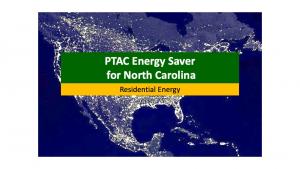- 9 reads

Our GREENandSAVE Team is pleased to share information like this about sustainability solution providers. If you would like to submit information on your company, please contact us.
TIME TO ACT: Save 20% or more on HVAC. It’s important now more than ever for a sustainable future!
Optimizing PTAC units with a “smart” device is a fast, easy, and cost-effective way to achieve Residential HVAC Energy Savings. A Packaged Terminal Air Conditioner is a type of self-contained heating and air conditioning system commonly found in: Hotels, Motels, Senior Housing Facilities, Hospitals, Condominiums, Apartment Buildings, and Add-on Rooms & Sunrooms.
Business owners and homeowners face increasing challenges with energy costs to save energy and money in North Carolina. PTAC Energy Saver offers an Adaptive Climate Controller (ACC). It is a proven HVAC energy saving devicethat quickly installs on PTAC units. There are many companies that claim to produce energy savings, but the ACC device is multi-panted and proven over many years. Plus, it has extensive validation tests by organizations such as:
- ConEdison, Manhattan Plaza New York City
- Environmental Test Laboratory, Ohio
- EME Consulting Engineers (Third Party), Sponsored by NYSERDA, New York
- State University of New York, Oneonta, NY
- Tim Garrison (Third Party Testing)
- McQuay Cooling Tests
- Purdue University Tests (Phoenix)
- ConEdison Tests by ERS
Typically, when an HVAC system turns off, shortly after, the blower fan motor turns off. The ACC reprograms the blower fan not to shut off but to throttle back the rpm airflow to an exceptionally low speed, quiescent level airflow or “idle speed”. This allows for a gentle but continuous air movement into the building that helps keep equilibrium of climate conditions in the occupied space and saved energy.
PTAC Energy Saver can help you navigate the complexity of HVAC energy saving choices: CONTACT PTAC Energy Saver
Here is an example of some Residential HVAC Energy Saving info for North Carolina:
WRAL 5 On Your Side: Five ways to cut down on your energy bill
RALEIGH, N.C. — As the temperatures rise, WRAL Five on Your Side is helping you save money and stay safe with a summer survival guide.
Last month, Five On Your Side told you how to secure your home before you head out for vacation, and now we're showing you how to beat the heat without breaking the bank.
According to the U.S. Environmental Protection Agency, the average American spends $2,000 per year on energy bills, but it doesn’t have to be that way.
WRAL Five on Your Side's Keely Arthur invited Duke Energy spokesperson Jeff Brooks into her home to show her how to make it more energy efficient.
“Most of these things take just a few minutes or they’re something you can do on a Saturday afternoon,” Brooks said.
Here are five simple things that work, and how to implement them.
1. Close your blinds and consider blackout curtains
If there’s one thing we get a lot of in North Carolina, it’s summer heat. First, close your blinds and consider blackout blinds to block the sunlight that would otherwise come through.
“It can serve as a greenhouse effect that can increase the temperature in your home,” Brooks said.
2. Use ceiling fans
Next, flip on your ceiling fan. Having a fan on won’t cool the room itself, but it makes anyone in it feel much cooler.
“Ceiling fans can actually make you feel up to four degrees cooler than it actually is in the room,” Brooks said.
3. Raise your thermostat ... a little
Turning a fan on will allow you to raise your thermostat a bit higher. Brooks told Five on Your Side that for every two degrees you increase your thermostat this summer, you can save 5% on cooling costs per month.
“You want to make sure you set that ceiling fan to a counterclockwise rotation,” Brooks added.
4. Switch out your air filters
Next, switch out your air filters. Using dirty, out-of-date filters can increase your bill by 20%, so be sure to switch those out every one to three months.
“If you have a clogged air filter that unit is going to work a whole lot harder,” Brooks said.
5. Switch to LED light bulbs
Finally, make the switch to LED light bulbs.
“Lighting is another thing that adds up in your home," Brooks said. "You think about all the different lights you have from lamps to chandeliers, and that’s a great opportunity to save energy by switching to low energy use LED bulbs.
"LED bulbs use about one-tenth of the energy of a standard light bulb."
The Consumer Federation of America estimates switching to LEDs can save the average home about $8.33 a month.
“These are simple things that you can do that will really make a big difference,” Brooks said.

